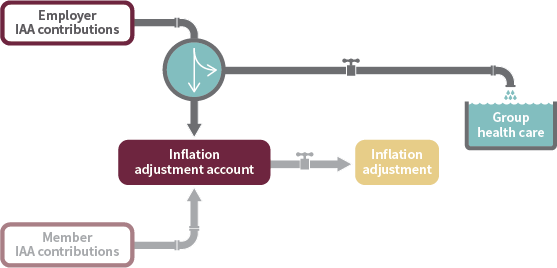
Funding of health and dental benefits in retirement
The optional extended health care and dental coverage available to retired members provides peace of mind at an affordable cost.
As a retired member, you will have access to optional extended health care and dental coverage.
While you’re working as an employee, your extended health care and dental coverage is likely paid for in full or in part by your employer. However, when you retire and apply for your pension, that coverage ends.
That’s why the extended health care and dental coverage offered through BC's Public Service Pension Plan can be so important. As a retired member, you currently have access to competitive group rates, and partially or fully subsidized premiums for extended health care coverage. This provides the peace of mind that comes from knowing you will be reimbursed for some of the medical and dental expenses that aren’t covered by provincial health care plans. Coverage under the retiree plan is different from and more limited than when you were working. You apply for this coverage when you apply for your pension.
How group health benefit subsidies are funded
Subsidies for retirement group health benefits (extended health care) are funded by employer contributions. Neither member contributions nor investments can be used for retirement group health benefit subsidies. With the rapidly growing number of retired members and rising cost of prescription drugs, it will likely cost more in future years for the plan to provide extended health care coverage. Over the long term, this could lead to funding challenges for subsidized retirement group health benefits.

The board aims to ensure these optional benefits can be maintained for the long term. That’s why the board regularly assesses whether current health benefit funding is sufficient to cover future needs and whether changes to current benefits could extend the duration of funding for retired members.
It’s important to remember that extended health care and dental coverage is not guaranteed. This means coverage can change at any time, and your premiums, subsidies and deductibles could increase, decrease or be eliminated.
What’s covered?
If you enrol in the extended health care plan, you may be reimbursed for the cost of prescription drugs, vision care, hearing aids, medical aids and supplies, as well as services from physiotherapists and other medical professionals.
If you enrol in the dental plan, you may be reimbursed for costs associated with preventive and restorative dental services. There are two dental plans to choose from, with different premiums, deductibles, limits and eligible services for each.
Paying your monthly premiums is simple and straightforward – premiums can be deducted for your extended health care and dental coverage from your monthly pension payment. If your pension is not large enough to cover the cost of the benefits, you can arrange to pay the insurance carrier directly through pre-authorized debit from your bank account. An early deductible and maximum lifetime amounts will apply to extended health care. There is an annual maximum for dental.
Affordable rates
In 2016, the Public Service Pension Board of Trustees worked with the boards of the Teachers’ and College pension plans to negotiate a competitive group rate with Green Shield Canada. Together, the boards were able to take advantage of the buying power of the combined 60,000 retired pension plan members and reduced administrative costs.
Green Shield Canada became the plan’s extended health care and dental insurance carrier on April 1, 2017. The rates we negotiated with Green Shield are significantly less than what you would pay as an individual seeking extended health care and dental coverage.
Subsidized premium based on pensionable years of service
An advantage of extended health care coverage through the plan is that the cost of your extended health care premium is currently subsidized based on your years of pensionable service. The more years of pensionable service you have, the higher your subsidy and the lower your premium. And if you have 10 years or more of pensionable service, your full premium is currently paid for by the plan.
The plan does not subsidize extended health care premiums for spouses and dependants.
The dental plans are voluntary and not subsidized.
External links for health coverage for retired members
Medical Services Plan of BC premium assistance
